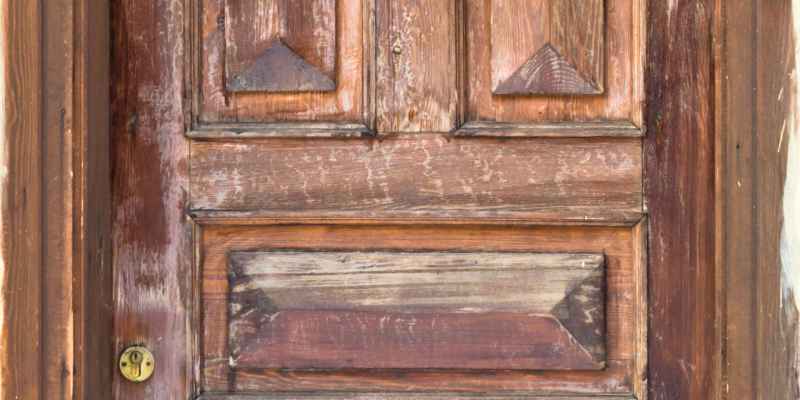To stain a pine door, follow these steps: Prepare the surface by sanding it, clean the door thoroughly, apply a wood conditioner, and finally, apply the stain evenly. Staining pine doors can be done by following a few simple steps.
First, sand the door to create a smooth surface. Next, clean the door to remove any dirt or debris. Then, apply a wood conditioner to help the stain absorb evenly. Finally, apply the stain evenly and allow it to dry completely.
By following these steps, you can achieve a beautiful and long-lasting stain on your pine doors.
Choosing The Right Stain
Staining pine doors can be a daunting task, but with the right technique, it can yield beautiful results. Learn how to stain pine doors effectively to enhance their natural beauty and preserve their longevity. Choose the right stain and follow a step-by-step process for a professional finish.
When it comes to staining pine doors, choosing the right stain is crucial to achieving the desired look. Stains not only enhance the natural beauty of the wood but also protect it from wear and tear. With a plethora of options available, it can be overwhelming to determine which stain is best for your pine door project. However, understanding the differences between water-based stains and oil-based stains is a good starting point.
Water-based Stains
Water-based stains are a popular choice for staining pine doors. These stains are made by suspending color pigments in water. Their advantages include a low odor, quick drying time, and easy cleanup with soap and water. Water-based stains also offer a wide range of colors to choose from, allowing you to achieve various finishes, from natural to darker shades. They are suitable for both interior and exterior applications, providing long-lasting protection to your pine doors.
It is essential to note that water-based stains have a thinner consistency than oil-based stains. As a result, they tend to be absorbed more deeply into the wood, resulting in a more transparent finish. This transparency allows the natural grain of the pine to show prominently, lending a beautiful, rustic appeal to your doors.
Oil-based Stains
If you are looking for a stain that offers rich and deep colors, oil-based stains are a fantastic choice for your pine doors. These stains are made by combining color pigments with a drying oil, such as linseed oil or tung oil. Oil-based stains provide excellent penetration into the wood, offering a strong and durable finish.
One of the notable advantages of oil-based stains is their ability to enhance the natural richness and warmth of pine wood. This makes them ideal for achieving a traditional or antique look. However, it’s worth mentioning that oil-based stains have a longer drying time compared to water-based stains, typically requiring around 24 hours to dry completely. Additionally, they have a stronger odor and require solvents, like mineral spirits or paint thinner, for cleanup.
When using oil-based stains, it’s important to consider the ventilation of your workspace and take proper precautions, such as wearing protective gloves and a mask, to ensure your safety.

Preparing The Pine Doors
Learn how to stain pine doors effectively with these easy-to-follow steps. Achieve a beautiful and durable finish that will enhance the natural beauty of your pine doors.
Before staining your pine doors, it’s crucial to properly prepare them. This will ensure a smooth and even finish that will enhance the beauty of the wood. There are a few key steps involved in preparing your pine doors, including sanding and smoothing the surface, as well as applying wood conditioner.
Sanding And Smoothing The Surface
To achieve a flawless finish, start by sanding the surface of your pine doors. This step is essential as it helps remove any imperfections or unevenness in the wood. Begin with a coarse-grit sandpaper (around 80 grit) to get rid of any rough patches. Move the sandpaper in the direction of the grain, using long, even strokes.
Once you have removed the roughness, switch to a finer grit sandpaper (around 120-150 grit) to further smooth the surface. This will help create a polished and refined look for your pine doors. Again, sand in the same direction as the grain, applying gentle pressure. Remember, consistency is key.
After sanding, it’s important to remove any dust or debris that may have accumulated. Use a clean, dry cloth or a vacuum to thoroughly clean the surface. This will ensure that the stain adheres evenly and provides you with the desired results.
Applying Wood Conditioner
Now that you’ve achieved a smooth surface, it’s time to apply wood conditioner. This step is especially crucial when working with pine, as it is a softwood that tends to absorb stain unevenly. A wood conditioner helps to prepare the wood for staining, ensuring a more even and consistent color.
Before applying the conditioner, gently stir it to ensure it is well mixed. Using a brush or a clean cloth, apply a thin and even layer of wood conditioner to the pine doors. Make sure to work the conditioner into the wood, covering the entire surface. Allow the conditioner to penetrate the wood for the recommended time, usually around 15-20 minutes.
After the designated time has passed, wipe away any excess conditioner with a clean cloth. Be sure to remove it thoroughly, as any excess can prevent the stain from properly adhering to the wood.
By following these steps, you can achieve a professionally stained pine door that enhances the natural beauty of the wood. Next, we will discuss the actual staining process and the best techniques to achieve a stunning finish.
Applying The Stain
Applying the stain to pine doors is a straightforward process. With careful preparation and the right tools, you can achieve a beautiful and durable finish on your pine doors. Follow these steps to learn how to stain pine doors effectively.
When it comes to staining pine doors, the application process plays a crucial role in achieving the desired finish. Before diving into the application, it’s important to understand the two main stain application techniques: brushing and wiping. Each technique has its own advantages and considerations, so let’s explore them further.
Brushing Vs. Wiping
Brushing and wiping are two popular methods for applying stain to pine doors. Both techniques have their own unique benefits and considerations. Here, we’ll compare and contrast these techniques to help you choose the best one for your staining project.
Stain Application Techniques
1. Brushing: This technique involves using a brush to apply the stain onto the surface of the pine door. It allows for more even coverage and helps reach into the smaller crevices and imperfections of the wood. Brushing is ideal for larger surface areas as it provides a faster application process.
2. Wiping: In contrast to brushing, wiping involves using a cloth or rag to apply the stain. This technique provides more control over the intensity of the color and allows for a more natural, rustic look. Wiping is recommended for smaller projects or when a lighter or more translucent finish is desired.
When applying stain using either technique, it’s important to work in small sections to ensure even coverage. Begin by cleaning the surface of the pine door to remove any dust or debris. Apply the stain in the direction of the wood grain, making sure to spread it evenly. Allow the stain to penetrate the wood for the recommended time, and then wipe off any excess stain with a clean cloth. Follow the manufacturer’s instructions for drying time and additional coats, if necessary. Remember to work in a well-ventilated area and wear protective gloves and eyewear throughout the staining process.
In conclusion, understanding the differences between brushing and wiping techniques is essential when staining pine doors. Consider the size of your project, the desired finish, and the level of control you want over the color intensity. Whether you choose to brush or wipe, always follow proper application techniques for a professional-looking finish.
Achieving The Desired Finish
When it comes to staining pine doors, achieving the desired finish can make a significant difference in enhancing the overall look of your doors. Whether you want a traditional, rustic, or modern finish, there are a few techniques you can use to achieve the desired result. In this blog post, we will explore two effective methods that can help you achieve the perfect finish for your pine doors.
Layering Stains For Depth
If you’re looking to add depth and dimension to your stained pine doors, layering stains is a great technique to consider. Layering involves applying multiple coats of different stain colors to create a unique and rich finish. To achieve this, follow these steps:
- Start by sanding the pine doors to remove any imperfections and create a smooth surface.
- Apply a base coat of stain using a brush or a cloth. This will serve as the foundation for your layered finish.
- Once the base coat is dry, choose a second stain color that complements the first one. Apply the second coat of stain using a brush or cloth, focusing on areas where you want to create depth and dimension.
- Allow the second coat to dry and assess the result. If necessary, repeat the process with additional stain colors until you achieve the desired depth and richness.
- Finish the staining process by applying a clear topcoat, which will protect the stained surface and enhance its durability and longevity.
Using A Clear Topcoat
To ensure a long-lasting and professional finish for your stained pine doors, it’s important to apply a clear topcoat. The topcoat serves as a protective barrier against wear and tear, stains, and UV damage. Here’s how to apply a clear topcoat:
- Ensure that the stained pine doors are fully dry before applying the topcoat.
- Use a high-quality brush or a foam applicator to apply an even layer of clear topcoat. Work in long and smooth strokes, following the grain of the wood.
- Allow the topcoat to dry completely, following the manufacturer’s instructions.
- After the first coat is dry, lightly sand the surface with fine-grit sandpaper to remove any imperfections.
- Apply a second coat of clear topcoat for enhanced protection and a more polished finish.

Maintaining And Protecting Stained Pine Doors
Maintaining and protecting stained pine doors is essential to ensure their longevity and keep them looking beautiful for years to come. Proper care can help prevent damage from everyday wear and tear, as well as the effects of sunlight and moisture. In this section, we will discuss regular cleaning and periodic refinishing as key steps in maintaining your stained pine doors.
Regular Cleaning
To keep your stained pine doors looking their best, it’s important to establish a regular cleaning routine. This will help remove dirt, dust, and grime that can accumulate over time and potentially damage the finish. Here are some tips to help you with the cleaning process:
- Dust the surface of the door with a soft, lint-free cloth or a feather duster. This will help remove any loose particles that may scratch the wood.
- Mix a mild soap or wood cleaner with warm water in a bucket. Avoid using harsh chemicals or abrasive cleaners, as they can strip the stain or damage the wood.
- Dip a soft sponge or cloth into the soapy water and wring out the excess moisture. Gently wipe down the stained pine door, working in small sections at a time.
- Pay special attention to any areas that may be stained or have visible marks. Use a soft-bristled brush or toothbrush to gently scrub these spots.
- Once you have cleaned the entire door, rinse the sponge or cloth with clean water and wipe down the surface again to remove any soap residue.
- Dry the door thoroughly with a clean, absorbent towel or allow it to air dry naturally. Avoid exposing the door to direct sunlight or excessive moisture during the drying process.
Periodic Refinishing
Despite regular cleaning, stained pine doors may require periodic refinishing to maintain their appearance and protect them from damage. Refinishing can help restore the color and shine of the stain, as well as provide an additional layer of protection against wear and tear. Here are some steps to consider when refinishing your stained pine doors:
- Clean the door thoroughly using the steps mentioned in the previous section. Ensure that the surface is free from any dirt, dust, or residue.
- If there are any scratches or imperfections on the door’s surface, consider sanding them lightly using fine-grit sandpaper. This will help create a smooth and even surface for the new finish.
- Apply a suitable stain or finish to the door using a brush, roller, or spray. Follow the manufacturer’s instructions for the recommended application method and drying time.
- Allow the stain or finish to dry completely before applying additional coats. Multiple thin coats are usually preferred over a single thick coat for a more even and durable finish.
- Once you have achieved your desired level of color and protection, allow the door to cure for the recommended time before using it again. This will ensure that the finish has fully hardened and is less susceptible to damage.
By regularly cleaning and periodically refinishing your stained pine doors, you can maintain their beauty and protect them from everyday wear and tear. Remember to always follow proper cleaning and refinishing techniques to preserve the integrity of the wood and enhance the longevity of your doors.
Conclusion
To summarize, staining pine doors can be a transformative process that enhances their natural beauty while protecting them from wear and tear. By following the steps outlined you can achieve professional-looking results, even if you’re a beginner. Remember to gather the necessary materials, prepare the door properly, and choose the right stain color.
With patience and attention to detail, you’ll be able to enjoy stunning pine doors that add elegance and charm to your living space. Happy staining!


